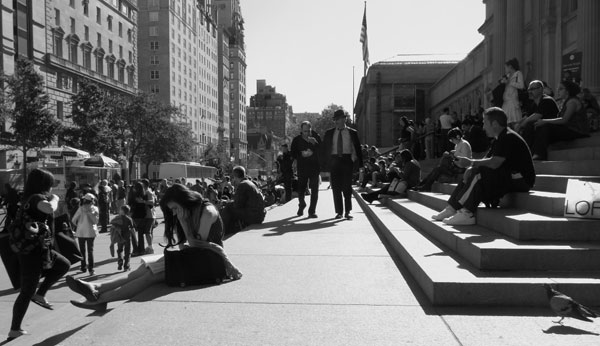Middle-class Americans have alternatively immersed themselves in and withdrawn from public urban spaces. In the early nineteenth century, the streets and squares of American center cities were commonly crowded, filthy, and dangerous – certainly no place for a “respectable” woman. By the end of that century, those same spaces had become even more crowded, but were now elegant and enticing – just where “respectable” women went to lunch and window-shop.
By the 1970s, however, middle-class Americans were again avoiding those streets and plazas. Television and the growth of suburbia had drawn many people into their homes. The center cities’ growing poverty and crime drove people away, leaving great American downtowns with abandoned stores and empty plazas. (See these previous posts: here and here.) We would expect, given all the speculations about how today’s communications technologies enable Americans to curl up in their burrows, for the flight from public spaces to have continued. Why go out at all? And if you do, why linger in public spaces?
Keith Hampton, Lauren Sessions Goulet, and Garrett Albanesius just reported a study in which they literally compared pictures of Americans in public spaces in 2010 to similar pictures in 1980. They found the pessimistic descriptions of changes disconfirmed.
What the Camera Saw
Hampton and his colleagues obtained access to time-lapse films taken in 1979 and 1980 of four different public spaces: Philadelphia’s Chestnut Street between 10th and 11th Streets; Boston’s Downtown Crossing; and in New York City, a sidewalk next to Bryant Park and the steps of the Metropolitan Museum of Art. In 2008 and 2010, Hampton’s team filmed those same spaces at comparable times in comparable weather and took pains to make other aspects of their procedure comparable to that of 30 years earlier. Then their team coded in detail what could be seen in both sets of films.
They saw roughly the same number of people per fifteen-second clip then and now*; they saw a higher proportion of people “lingering” in 2008 and 2010; and they saw, in contradiction to most speculations, that “there has been a decline in the tendency for people to spend time alone and a corresponding increase in the proportion of people in groups.” Except on the block of Chestnut Street, which is largely a thoroughfare for commuting, the proportion of people who were by themselves declined notably.
Gender is a key part of the story. In most places, women formed a higher proportion of the people out in public in 2008/10 than 1979/80 (especially on the steps of the Met) and groups were more mixed by gender now than before. (Boston’s Downtown Crossing bucked these gender trends; the authors suggest that perhaps men got more into shopping after 1980.)
What about that presumed destroyer of public sociability, the cell phone? There were none in 1980, of course. Hampton and colleagues found that no more than 10 percent of the people they filmed in 2008 and 2010 were talking or texting on cell phones. Moreover, these individuals were overwhelmingly (except at the Met) by themselves. That is, phone users captured on film were rarely ignoring the people they were with.
The authors conclude that the fear that we are increasingly “alone together” in public spaces is not supported by this study. (Unfortunately, Hampton and colleagues try to frame their research with the claim that Americans have become more isolated in their private lives, a claim that is also not supported by the evidence.**) In seeking to understand the increase they found in public group activity and in public gender mixing, the authors emphasize that American women were much likelier to be working outside the home in 2008/10 than in 1979/80. We should also recognize that major American cities like New York, Philadelphia, and Boston have also changed in the last 30 years. They are significantly safer, their downtown residents are better off, and they have more “destination” activities – all developments likely to increase the presence of women, with or without cell phones.
* Calculated from Table 1.
** This blog has reviewed some of the debunking research, e.g: 1, 2, 3, 4. See, also here, here, and the Marsden-Srivastava chapter here.








